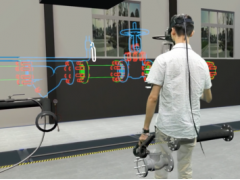(Ralph Rosen is HR manager of Sunshine Financial Services Co. He invites Mary Simpson from Newstart Language Training Center to give a lecture to the staff on taking notes and minutes at a business meeting. Jim, Hannah and Martin are participants at the lecture.)
场景:面试会议室 人物:Ralph、Mary、Jim、Martin、Hannah
Ralph: Good morning, everyone. My friend, Ms Mary Simpson from Newstart Language Training Center is here today to give us a talk on how to take effective notes and what we have to do to produce satisfactory meeting minutes. Let’s welcome.
Mary: Thank you. Good morning, everybody. It’s just a casual talk so feel free to interrupt me when you have any questions. OK. So generally speaking learning to take notes and minutes will help you remember important points in a telephone conversation, at a negotiation, a meeting or a lecture.
Jim: Seems a very important skill in business, Mary.
Mary: Yes, it really is. Well, we'll start from notes. So to make your notes accurate and objective, firstly you have to listen to the speaker carefully and actively. So by listening “actively”, I mean you can ask for clarification if you are unsure of a point, a decision or an action. Secondly, you should take notes in an outline format.
Martin: En, sorry to interrupt you, Mary. Can we use abbreviations?
Mary: Sure, you are encouraged, actually, to use abbreviations or even your own words but make sure that you will understand them later. So keep your notes brief and to the point. It is unrealistic to just write down every word.
Jim: Shall we pay attention to spelling and grammar?
Mary: Uh…no. Don’t worry about that as long as they are legible, you can rearrange them later. Just get the major points as quickly as possible.
Hannah: I heard there are three commonly used styles of notes. Can you tell us more specifically?
Mary: Generally speaking, these three types are pattern notes, flow-chart notes and numbered notes. So pattern notes is like brainstorming session in which you write down the ideas as they occur to you and you just show the way they connect up.
Jim: How can we do that?
Mary: Just write the topic right in the middle of a circle and then put different aspects of topic in different branches. And of course, branches can develop further. And pattern note is easier to produce especially in a meeting or a lecture.
Martin: OK, I see. What about the other two?
Mary: Well, the flow-chart notes shows you the process that the ideas occur, following from one step to the next with arrows to connect them. It is very easy for readers to follow. And this kind of note is good for a conversation or a talk in which ideas are presented in a chronological order.
Hannah: What is the third one?
Mary: The third one is the numbered notes. It places the idea in numbers. Each number shows one idea and is very easy to identify especially when the talker, you know, when the talk keeps on track. So it is easy to find relevant ideas later.
Ralph: Can I ask a question, Mary? How does a meeting minutes differ from notes?
Mary: Well, that's what I’m just about to cover actually. A minutes is a written record of what has taken place at a meeting and is kept for a future use. It usually includes what have been discussed, you know, who have participated the meeting, and what conclusions have been made. Like notes, you don't have to write down every word.
Martin: Then what is an effective way of taking minutes?
Mary: Usually you may start off your minutes at the top of a piece of paper by writing the name of the meeting, the venue, the date and time. And make sure you know the attendees that are present by their name, title and department they represent.
Hannah: Is it right that each company has a format for meeting minutes.
Mary: Yes, so you can use the format preferred by your company. It is better to get an agenda of the meeting with which you can follow the order. Make the minutes short and clear. Remember that the meeting minutes just needs to record the essence of the important discussions. And other information, all other information actually is just noise and should be excluded.
Martin: Oh, Mary. What should we do after taking minutes, then?
Mary: That's a good question. Type up the minutes as soon as possible after the meeting when your memory is still fresh,and ask as more attendants as possible to just look over the minutes before submitting the report to your boss. If anything is inaccurate or someone was misquoted, it can be corrected while each attendee still can remember a great deal of the meeting.
Jim: It seems that it’s not a difficult task when following these rules.
Mary: No, not at all.
Ralph: Well, thanks for the wonderful talk, Mary. It was really helpful.
Mary: You are welcome.

2016-05-13

2016-09-12

2017-09-18

2017-08-31

2017-08-09

2017-09-18